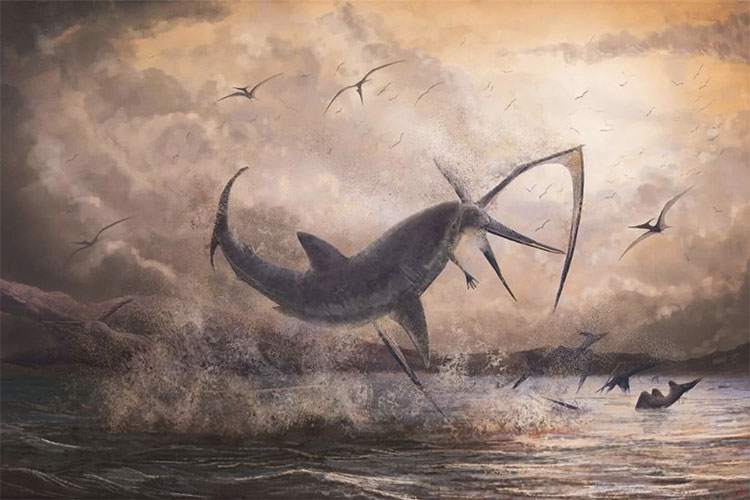Evidence of ancient sharks non-body grabbing the lizard's neck
The fossil tooth is a remnant of an intense aerial attack between a double-spotted shark and lizard.
Experts at the University of Southern California were shocked by the discovery of fearsome reptile fossils with a plugged shark's teeth while studying bones at the Los Angeles Natural History Museum, Fox News reported yesterday. . They assumed that this was the result when a two meter long shark escaped the water to attack one or the much larger dragon with a wingspan of 5.5 meters.

The tooth belonged to Cretoxyrhina mantelli, a common shark that lived at the same time as the winged lizard.
Fossil specimens reveal a winged lizard snapped by sharks on the neck, leaving a tooth that is deeply inserted into the vertebrae. The team found the tooth stuck between the tips of the neck vertebrae, clear evidence of the bite. The results of the study are published on December 14 in the Journal of Life and Environment Science.
It is possible that the attack occurred when the winged lizard was the most vulnerable, spread out close to the water, according to Michael Habib, assistant professor at Keck Medical School of USC and research assistant at the History Museum. Nature. Although winged lizards can land and take off from the water, they are quite clumsy on the sea and take a long time to fly.
The tooth belonged to Cretoxyrhina mantelli , a common shark that lived at the same time as the winged lizard. They are large, fast and strong, about 2.4 meters long, have the same shape and behavior as today's great white sharks, although they do not have relatives.
This is the first time the interaction between this shark and the winged lizard has been recorded. The fossil was excavated in the 1960s in the Smoky Hill Chalk area of Kansas State, USA, which was once a part of the vast inland waters in the late Cretaceous period.
- Interesting discovery of ancient animal species
- Discover new lizards in Kon Tum
- Discovered a new herbivorous giant lizard that lived more than 200 million years ago
- The unbelievable truth from weird animal tails
- Compare the size of shark species in the world
- Evidence of a neck brain surgery
- Catching a 6-bearing shark originating before dinosaurs
- Humans and sharks have the same ancestors
- Discovered new lizards living isolated for millions of years
- 370 million-year-old shark fossils discovered
- Dreadnoughtus long neck dinosaurs weigh only 40 tons
- Fossils reveal the ancestors of today's lizards and snakes
 Discovered an ancient centipede fossil 99 million years old
Discovered an ancient centipede fossil 99 million years old Discovered bat-like dinosaurs in China
Discovered bat-like dinosaurs in China Discovered a 200-year-old bronze cannon of the coast
Discovered a 200-year-old bronze cannon of the coast Discover 305 million-year-old spider fossils
Discover 305 million-year-old spider fossils